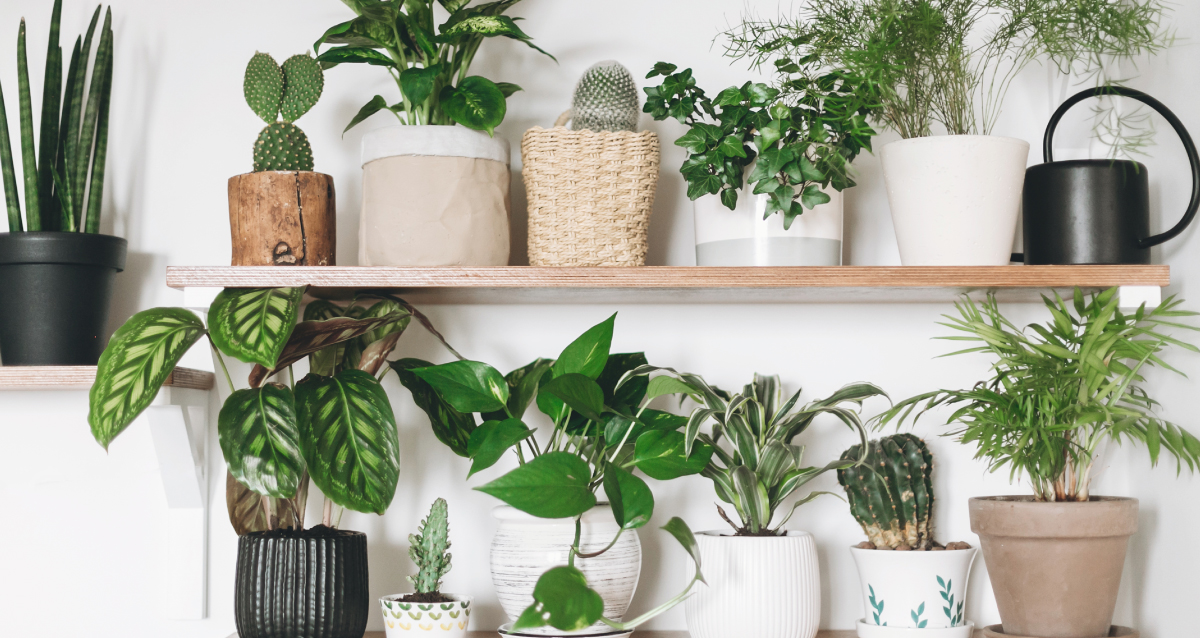A Beginner’s Guide to Houseplants
July 16, 2021

Houseplants are the trendy addition to your home that not only look great, but help purify the air as well. A few leaves are bound to turn brown when first getting into houseplants, but don’t give up! The team at McGuinn Hybrid Homes put together this guide of helpful tips to get you started on the right path.
Know Which Plants Work Best in Your Home
Not every plant is going to thrive in your home, and one of the main reasons is access to sunlight. Most plants you find at the store will label if it’s low light, medium light or bright light. Low light plants survive with no direct sunlight, so you can place your plant a good distance from the window comfortably or in a windowless bathroom. Medium light plants do well when there is some barrier, like a curtain or space between the plant and window. Bright light means there should be no barrier between the plant and light. Place these directly by a window, preferably a southern-facing one.
Our homes are designed to emit plenty of natural lighting with large windows and airy glass doors. Curious as to which plants will fit best in your space? Some really good low light plants are of the Sansevieria variety—known more commonly as snake plants. This is a great beginner plant because they are very low maintenance and do not require much water. They do best when you leave them be, and can even survive in dark corners of the home. Another great low light plant that can tolerate bright light is the pothos plant, which will reward you with long, trailing vines when it’s left alone to grow.
Ferns and anthuriums are great medium light plants. For bright light areas, try aloe vera or cacti.
Don’t Forget Drainage
Now that you’ve picked out the perfect plants for your space, you need to keep in mind the container that they’re in. It’s important that your plants have a drainage system in place for two important reasons. Drainage prevents over watering, because any water that the plant doesn’t need will be emptied out. Drainage also prevents root rot in your plants—a disease that can decay roots and kill your plants.
Look for a hole in the bottom of your planter, and you’re all set. But if you’ve fallen in love with a pot that doesn’t have drainage holes, there’s a trick—create a base layer of small rocks and place dirt on top when planting your plant. This will work the same as having a planter with a saucer underneath. Water will escape the soil and drain into the gaps of the rocks.
Set a Schedule
A common worry with houseplants is the fear of over or under watering them. Keep track of when you’re watering your plants on a calendar to avoid this. Some plants need more water than others, but a good rule of thumb is once a week. This can increase depending on the humidity in your house which will fluctuate during the seasons. Luckily, your energy efficient home is engineered to filter out excessive humidity. Summer months also means more sunlight, however, so twice a week might be your watering schedule for the season.
Research the plants that you have and try to not fuss over them too much. Letting soil dry out between watering will actually yield healthier plants.
Choosing a Home that is Healthy
With energy efficiency features in every McGuinn Hybrid Homes community, your home is always fostering a healthy and relaxing environment. Houseplants add an extra amount of air purifying to your home, offering eco-friendliness that looks good too.
When you’re ready to go green in every aspect of your home, contact McGuinn Hybrid Homes via online form or call (803) 917-5583. Our knowledgeable team can tell you all about our upcoming communities in the greater Columbia area.
Recent Posts

December 10, 2025
5 Essential Tips for Buying a New Construction Home in 2026

November 13, 2025
Fall in Love with Aiken: Why Life Shines in South Carolina’s Hidden Gem

October 13, 2025
Step Inside Style: Tour Our Fully Furnished Model Homes Across South Carolina and Georgia

September 5, 2025
Top 6 Tips for Hosting During Football Season in Your McGuinn Home

August 15, 2025
5 Reasons You’ll Love Living Near Downtown Greenville with McGuinn Homes
Blog Categories

When you have questions...OUR SALES TEAM HAS YOUR ANSWERS!



